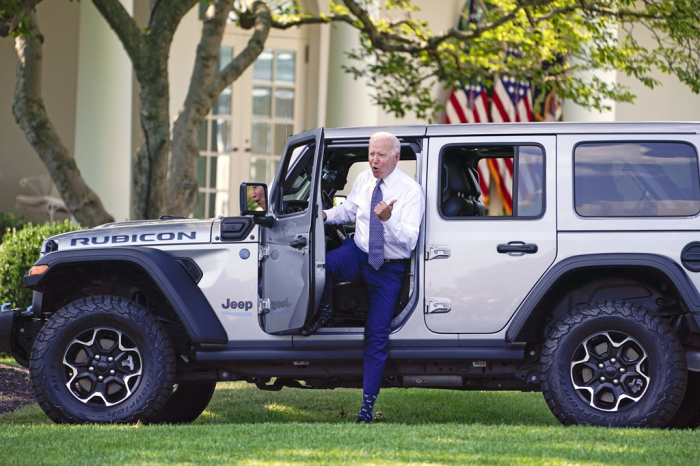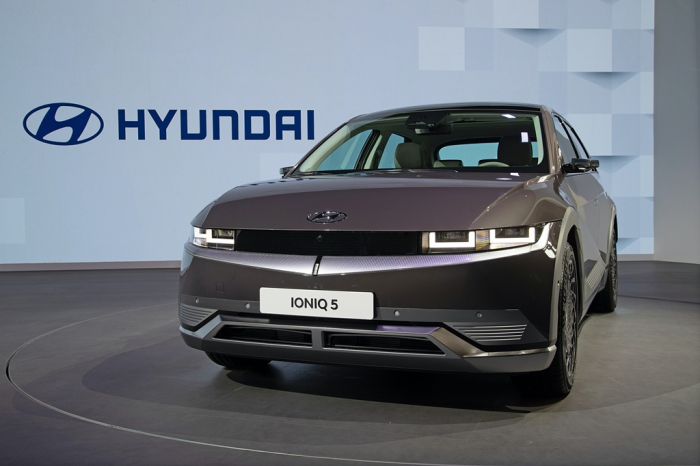Electric vehicles
Global carmakers to speed up EV push as governments pressure harder
US aims to make half of all new cars sold in 2030 electric, while EU plans to ban gasoline, diesel cars by 2035
By Aug 06, 2021 (Gmt+09:00)
4
Min read
Most Read
LG Chem to sell water filter business to Glenwood PE for $692 million


KT&G eyes overseas M&A after rejecting activist fund's offer


Kyobo Life poised to buy Japan’s SBI Group-owned savings bank


StockX in merger talks with Naver’s online reseller Kream


Meritz backs half of ex-manager’s $210 mn hedge fund



US and European governments are pressing harder with tough regulations to expand electric vehicles (EV) adoption for cutting emission. Global automakers are accelerating their EV push. Hyundai Motor Group, which sells 80% of its vehicles abroad, started revising its overall strategy.
US President Joe Biden on Aug. 5 signed an executive order aimed at making half of all new vehicles sold in 2030 electric.
“They’re a vision of the future that is now beginning to happen, a future of the automobile industry that is electric,” Biden said. “It’s electric, and there’s no turning back.”
Top executives of the “Big Three” US automakers – General Motors Co. (GM), Ford Motor Co. and Chrysler parent Stellantis N.V.-, who attended the signing ceremony, pledged to join the government’s plan. Hyundai Motor Co. said it supports the administration’s goal, according to Reuters.
Last month, the European Commission announced the “Fit for 55,” which aims to cut greenhouse emissions by 55% by 2030. The measures include a de facto ban to sell gasoline and diesel cars in the European Union (EU) by 2035.
South Korea joined such moves. The Presidential Committee on Carbon Neutrality on Aug. 5 released action plans to achieve carbon neutrality by 2050 including a target to replace 97% of cars on the road with the zero-emission vehicles by then. Given a replacement cycle, production and sale of internal combustion engine cars will be stopped from 2035 in the country, analysts predicted.
Hyundai Motor Group started completely revising its production and sales strategies. Hyundai Motor had planned to fully electrify its product lineup in major global markets such as the US and Europe by 2040. But the South Korea’s top automaker decided to move it forward.
ARMS RACE
Global automakers are expected to invest more in EV than their earlier plans in a bid to improve price competitiveness, as failure to meet those tougher regulations will lead to a fallout in the market, analysts said.
“It’s an arms race right now,” said Dan Ives, an analyst at Wedbush Securities, according to the Financial Times. “There’s a fear that if they’re not aggressive enough over the coming years, they’ll be left in the dust by the likes of Tesla.”
Hyundai Motor earlier announced that it plans to invest $7.4 billion in the US in five years and produce EVs in the country. Its US sales of eco-friendly models in the first seven months of this year accounted only for 6.4%.

To meet the Biden administration’s executive order to sell half of new cars as EV by 2030, Hyundai will have to bring the investment forward and pour more money.
The Big Three automakers continued to expand investment in EV. GM and Ford announced they will invest $35 billion by 2025 and $30 billion, respectively. Stellantis plans to spend 30 billion euro ($35.4 billion), while Volkswagen AG is set to invest 16 billion euro.
NEED GOVERNMENT HELP
Such moves are expected to accelerate the global EV adaption. The industry, however, wants the authorities to help clear speed bumps such as decreasing government subsidies and insufficient charging facilities.
In South Korea, for example, Hyundai Kona’s EV model price would be almost double of its gasoline version mainly due to battery costs without the government subsidies.
“Automakers need government support to help develop economies of scale,” said the Korea Automobile Manufacturers Association (KAMA) Chairman Jung Man-ki.
Other makers in the country such as GM Korea, Renault Samsung Motors and Ssangyong Motor Co. do not locally produce any EV yet. So, the domestic industry may not be able to meet the government’s goal.
“GM and Renault’s EV strategies do not include units here,” said Lee Hang-koo, executive adviser at the Korea Automotive Technology Institute. “As global headquarters prioritize production in their own countries, both GM Korea and Renault Samsung have no choice but to be pushed back.”
The country also needs to solve inconvenience of charging. It takes only three minutes to fill an internal combustion engine car, while it takes more than an hour to charge an EV. Given the government goal to introduce 1.13 million EVs and 15,000 fast chargers by 2025, the number of EV per fast charger will jump to as much as 76 units by then from 16 units as of February this year.
“The government should not pressure just to sell more EV but create conditions first for consumers to buy EV,” said an industry source.
Write to Il-Gue Kim, Hyung-Kyu Kim and Go-Woon Yi at black0419@hankyung.com
Jongwoo Cheon edited this article.
More to Read
-
 Luxury carsHyundai’s Genesis GV70 named MotorTrend’s 2022 SUV of the year
Luxury carsHyundai’s Genesis GV70 named MotorTrend’s 2022 SUV of the yearOct 21, 2021 (Gmt+09:00)
1 Min read -

-

Comment 0
LOG IN


